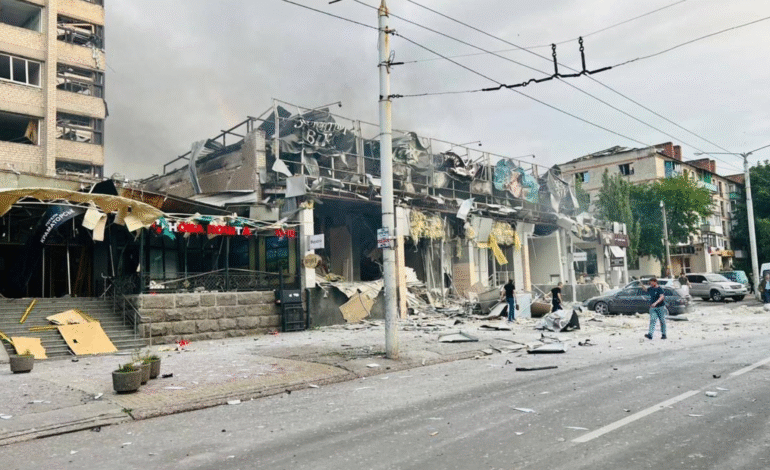Kremenchuk Under Fire: Russian Drone Strike Hits Heart of Ukraine

In a sharp escalation of Russia’s ongoing aggression against Ukraine, a precision drone strike early on Sunday, July 6, 2025, targeted a key military enlistment facility in the city of Kremenchuk, located in Ukraine’s Poltava region. The attack, confirmed by the Ukrainian Ground Forces via their official Telegram channel, directly struck the Kremenchuk District Territorial Recruitment and Social Support Center. Alongside this government facility, a nearby residential building also suffered damage marking yet another troubling instance of civilian areas being swept into the conflict.
This assault adds to the long chain of drone strikes and missile attacks that have characterized the evolving warfare between Russia and Ukraine. As the war drags on into its third year, the use of unmanned aerial vehicles (UAVs) has become a dominant feature of modern combat raising fresh alarms about the vulnerability of both military and civilian infrastructure across Ukraine.
Ukraine Reports Direct Drone Strike on Key Recruitment Center
According to the Ukrainian Ground Forces, the drone strike occurred at approximately 09:35 a.m. local time. The unmanned aerial systems used by Russian forces reportedly hit their targets with surgical precision, leaving significant damage in their wake. The primary target, the Kremenchuk District Territorial Recruitment and Social Support Center, functions as a pivotal hub for Ukraine’s military conscription and social services for soldiers and their families.
The recruitment office in Kremenchuk plays a vital role in Ukraine’s ongoing military mobilization efforts. Located in central Ukraine, the Poltava region has not been as frequently targeted as frontline areas, making this attack a significant escalation. The strike’s timing and location hint at a deliberate strategy to undermine Ukraine’s manpower pipeline and demoralize local communities.
Nearby Residential Building Also Hit in Attack
What deepened the concern surrounding this strike was the reported damage to a nearby residential structure. Civilian lives continue to be at risk, even far from the war’s epicenters. Although preliminary reports state that no personnel from the enlistment center or local residents were killed or injured, the full extent of the casualties remains under assessment.
Emergency services were swiftly dispatched to the scene to extinguish fires, clear debris, and assess structural damage. While Ukrainian officials are currently verifying the details and updating casualty information, local sources confirmed that the damage to the civilian building included shattered windows, displaced residents, and minor injuries due to flying debris.
This targeting of non-combatant areas once again places Russian military tactics under scrutiny, especially as the international community continues to call for adherence to humanitarian principles and the protection of civilian infrastructure.
Russia’s Tactical Shift Towards Drone Warfare
Drone warfare has increasingly dominated Russia’s military approach, especially as sanctions and battlefield losses have challenged the availability of traditional combat systems. Over the past year, Russia has ramped up its deployment of both domestically manufactured and Iranian-supplied drones particularly the Shahed-136 model for reconnaissance and strike purposes.
Military analysts believe the use of drones in this instance reflects a strategic calculation. Unlike large-scale missile barrages that risk international condemnation, drones offer plausible deniability, precision, and lower economic cost. The strike on Kremenchuk may represent a larger campaign designed to dismantle Ukraine’s logistical and recruitment infrastructure without resorting to full-scale missile attacks.
Furthermore, drones allow for flexible targeting deep within Ukrainian territory. The attack on a relatively stable and safe region like Poltava signals an evolving pattern of long-range, asymmetrical warfare intended to spread fear, disrupt government operations, and strain emergency response capabilities.
Civilian Infrastructure Under Growing Threat
The implications of this attack are deeply troubling for civilians living in regions previously considered safe. As drones grow harder to detect and intercept, they pose a greater threat to infrastructure that was not initially designed to withstand such precision strikes.
For Kremenchuk residents, this incident serves as a reminder that no region is immune from the war’s destructive reach. Damaged residential areas in close proximity to military targets amplify the psychological trauma experienced by civilians. It forces local governments to reconsider security protocols and contingency planning for potential future attacks.
This attack also renews concerns over international humanitarian law. According to the Geneva Conventions, warring parties are obligated to distinguish between military and civilian targets and minimize harm to civilian life. The proximity of this drone strike to residential buildings will likely invite further scrutiny from international watchdogs and humanitarian organizations.
Ukraine’s Defense Strategy Faces New Challenges
While Ukraine has made significant strides in developing air defense capabilities, particularly around key urban centers like Kyiv and Kharkiv, regions like Poltava still remain vulnerable. Anti-air systems such as NASAMS and IRIS-T have been effective in intercepting missiles but are less suited for low-flying, low-cost drones that can maneuver under radar detection thresholds.
Ukraine’s Defense Ministry is now faced with the complex challenge of deploying more agile and responsive defense systems across a wider geographical range. This includes the integration of electronic warfare units, counter-drone technology, and localized surveillance networks.
The Kremenchuk strike could also affect morale and operational capacity within the Ukrainian Armed Forces. Recruitment centers serve not only as logistical nodes but also as symbolic representations of national resistance. Disabling these centers, even temporarily, may delay troop mobilization and affect public confidence in the military’s protective reach.
Russia’s Broader Psychological Warfare Tactics
Military analysts believe the psychological element of these strikes cannot be ignored. By targeting a recruitment office an institution deeply tied to national defense and collective sacrifice Russia sends a chilling message intended to undermine Ukrainian resolve.
The attack is symbolic in nature. It seeks to instill fear, erode community trust in government protection, and dissuade potential recruits from enlisting. This form of psychological warfare, carried out through tactical precision strikes, complements the broader strategy of hybrid warfare involving cyberattacks, disinformation campaigns, and economic sabotage.
In the face of such tactics, Ukraine is responding by rallying local authorities and civil defense units. Social media platforms, including the official Telegram channels, are being used not only to share news updates but also to mobilize community resilience and spread accurate information countering Russian disinformation efforts.
Global Reactions and International Monitoring
Although this specific incident has not yet drawn formal responses from Western allies, the ongoing pattern of targeting infrastructure in central Ukraine will likely influence discussions at upcoming NATO and EU security forums. Monitoring agencies including the Organization for Security and Co-operation in Europe (OSCE) are expected to track and evaluate satellite imagery and damage assessments related to the Kremenchuk strike.
Meanwhile, humanitarian organizations have urged both sides to respect international norms and reduce harm to civilians. The United Nations Office for the Coordination of Humanitarian Affairs (OCHA) has highlighted the growing number of civilian casualties in non-frontline zones as a distressing trend requiring urgent attention.
With the war entering a protracted phase, these incidents are poised to shape the geopolitical discourse surrounding military aid, sanctions, and diplomatic negotiations.
Lessons for the UAE and Broader Middle East
Though the Kremenchuk incident occurred thousands of kilometers from the Gulf, its strategic lessons resonate deeply in the Middle East particularly for countries like the UAE, Saudi Arabia, and Qatar that are actively modernizing their defense sectors.
The rise of drone warfare serves as a critical case study for Gulf nations focused on building layered air defense systems, counter-drone capabilities, and cyber resilience. UAE military planners have long recognized the threat posed by unmanned aerial systems especially after incidents like the 2022 Houthi drone attack on Abu Dhabi’s oil facilities.
Investments in radar technology, AI-powered surveillance, and international military cooperation such as the UAE’s defense partnerships with the United States, France, and Israel are becoming increasingly important in this shifting global security environment.
Moreover, media platforms across the UAE and Middle East are closely monitoring how warfare is evolving in Eastern Europe, as these patterns often influence regional military doctrine, defense procurement strategies, and national security planning.
War’s Reach Continues to Expand
The July 6 drone strike on Kremenchuk marks yet another moment in the expanding narrative of modern warfare where frontlines are fluid, and civilian areas are never fully insulated from conflict. As Ukraine continues to defend its sovereignty, it faces increasingly sophisticated threats aimed not just at its soldiers but also at the fabric of its civil society.
The UAE and other Middle Eastern nations would do well to study these developments carefully, adapting their own national strategies accordingly. In a world where wars are waged by machines, the importance of preparedness, resilience, and technological superiority has never been more pressing.








1 Comment
[…] a dramatic escalation of hostilities, Russia launched a massive wave of air strikes across Ukraine on July 19, deploying nearly 400 drones and […]
Comments are closed.